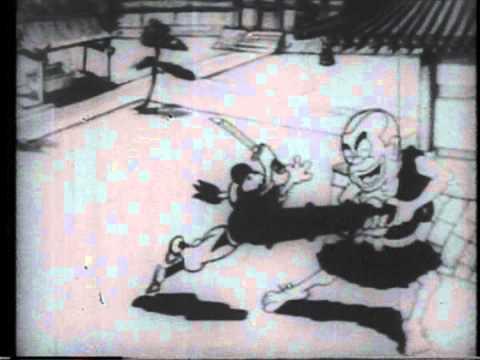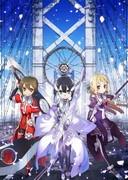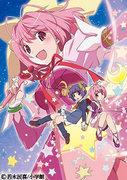Ninjutsu Hi no Tama Kozo Edo Chapter - What is the appeal of this classic anime where tradition and innovation intersect?

"Ninjutsu Hinotama Kozo Edo no Maki": A work that marked the dawn of Japanese animation■ Public Mediatheater ■ Original MediaAnime Original ■ Release dateNovember 9, 1934 - January 1, 0000 ■Distribution companyDistributed by Nikkatsu ■ Number of EpisodesEpisode 1 ■ DirectorYoshi Tanaka ■ ProductionNikkatsu (Kyoto Film Studio Manga Department) ■ Storydetail While the foolish lord was patrolling the Nihonbashi area, he noticed a beautiful girl wearing a ball. He made a move on her, so she ran away. The fireball boy went on a rampage against the captors to save her. ■Explanationdetail The illustrator, Shichima Sakai, published the manga "Shin Takarajima" in collaboration with Osamu Tezuka in 1947, and is also the father of the Tezuka Osamu we know today. At the time, he was active as an animator. ■ Main staffdetail・Illustrations: Shunichi Funaki, Hiroo Nagai, Shichima Sakai ・Music: Yoshinobu Shiraki ■ Background and historical significance of the work"Ninjutsu Hinotama Kozo Edo" is a Japanese animated film released in 1934 that has great historical significance. The film was released theatrically by Nikkatsu and attracted attention as one of the rare animated films of its time. In particular, the film, directed by Yoshi Tanaka and produced by the team at Nikkatsu's Kyoto Studio Manga Department, showcased the potential of early animation techniques and storytelling. This film reflects the social conditions and people's lives of the time through a story that revolves around the characters of the Fool Lord and the Fireball Boy. The scene where the Fool Lord inspects Nihonbashi Bridge depicts the customs and culture of the Edo period, and is visually appealing as well as historically valuable. The scene where the Fireball Boy goes on a rampage to save his daughter emphasizes action and heroism, leaving a strong impression on the audience. Drawing and animation techniquesThe team of Shunichi Funaki, Hiroo Nagaiwa, and Shichima Sakai, who were responsible for the drawings, completed this work using cutting-edge animation techniques for the time. Shichima Sakai in particular was known as the mentor of Osamu Tezuka, and his drawing techniques had a major influence on this work. Sakai's drawings, which depicted the characters' movements and expressions realistically, encouraged deep emotional involvement from the audience. Also, depicting the movements and battle scenes of Hidama Kozou was extremely challenging given the technical limitations of the time. However, thanks to the efforts of the staff, smooth movements and dynamic action were achieved, maximizing the visual impact. It can be said that these technical achievements had a major impact on the development of later Japanese animation films. ■Music and SoundYoshinobu Shiraki, who was in charge of the music, provided a combination of traditional Japanese instruments and a Western orchestra to give the work a unique atmosphere. In particular, in the scene where the Fireball Boy appears, the sounds of drums and taiko drums were used effectively to heighten the tension, and combined with the visual action, drew the audience in. In addition, in the scene depicting the foolish lord's comical behavior, light-hearted melodies were used to create a humorous atmosphere. The sound effects were also an important factor in enhancing the appeal of this work. The sound of the fireballs of the Fireball Boy and the sound effects in the battle scenes complemented the visual expression and deepened the audience's immersion. These sound effects were very advanced considering the technical level of the time, and it can be said that they contributed to the development of sound technology in later animated films. ■Characters and StorytellingThe story of "Ninjutsu Hi no Tama Kozo Edo no Maki" revolves around the contrasting characters of the Foolish Lord and the Fireball Boy. The Foolish Lord is a powerful character who repeatedly commits foolish acts, and while his actions provide laughs for the audience, they also contain satire on the society of the time. On the other hand, the Fireball Boy is portrayed as a hero with a strong sense of justice, and his actions of standing up to save the weak moved the audience. In terms of storytelling, the comical actions of the foolish lord and the brave actions of the Fireball Boy are intertwined, creating an exquisite balance between tension and humor. Set against the backdrop of the customs and culture of the Edo period, the story portrays the universal theme of the conflict between good and evil, deeply moving the audience. The scene in which the Fireball Boy goes on a rampage to save the girl captured the audience's hearts with its visual impact, building up to the climax of the film. ■ Evaluation and influence of the work"Hinotama Kozou: Edo" was highly acclaimed when it was released, and its influence continues to this day. While it represents an early example of technical innovation, it also achieved great success in storytelling and character portrayal. The character of Hinotama Kozou, in particular, is a prototype for the hero image in later Japanese animated films, and its influence is immeasurable. This work is also important as it marks the beginning of the careers of such animation masters as Shichima Sakai and Osamu Tezuka. Shichima Sakai's drawing techniques and storytelling talents were widely recognized through this work, and contributed to the development of later animated films. Furthermore, the success of "New Treasure Island," which Osamu Tezuka co-wrote with Shichima Sakai, shows how influential this work was. ■ Recommendations and how to watch"Ninjutsu Hinotama Kozo Edo" is an essential piece of Japanese animation history, and I highly recommend it to anyone with an interest in animation and film. Not only does this film allow you to experience the fascination of early animation techniques and storytelling, but it also offers a visually stunning portrayal of the customs and culture of the Edo period. Currently, it is possible to watch it on DVD or online streaming services. In particular, it may be possible to watch it on archive sites that specialize in historical animation films, or on Nikkatsu's official website, so if you are interested, be sure to check them out. Also, related books and materials such as "History of Japanese Animation Films" may be useful references. ■ Summary"Ninjutsu Hi no Tama Kozo Edo" is a Japanese animated film released in 1934, and its historical significance and technical innovation are enormous. Through the contrasting characters of the Fool Lord and the Fireball Boy, this film portrays the customs and culture of the Edo period while also depicting the universal theme of the conflict between good and evil. With an exquisite combination of elements such as drawing, music, and sound effects, this film was not only highly acclaimed as one of the early animated films, but also had a major impact on the development of later Japanese animated films. Anyone interested in animation and film should definitely watch this film and experience its charm and historical significance. |
<<: Dan'emon Hanawa's Monster Hunt: A fascinating story and in-depth character exploration
Recommend
Master Mosquiton '99: A review of the charming characters and humorous story
"Master Mosquiton '99": A journey t...
"Lin Chi-ling of the wrestling world" leaps onto the ring in a sexy way, netizens: I really want to be thrown by her
Recently, a netizen posted a photo of a beautiful...
"Ghost Blows Out the Light: The Star Divination" releases advanced trailer and is expected to be released in 2021
The movie "Ghost Blows Out the Light: The St...
Netflix announces comprehensive business cooperation with four animation companies following Bones
Netflix Animation's official Twitter account ...
"The Legend of Luo Xiaohei" will be broadcast in Japan this year, and Hanazawa Kana will voice Luo Xiaohei
The classic Chinese animation "The Legend of...
The director of "Avengers 4" said that what they want to shoot most is "Secret Wars"
The Russo brothers, directors of "Avengers 4...
Bar
Special Assembly - History of the General Electio...
'WINNER' Minna no Uta - Review and recommendation of moving melody and story
WINNER Minna no Uta - Winner - All-round review a...
Review of "A Half Moon": A moving story and beautiful visuals
"The Sky Where the Half Moon Rises": A ...
Netflix's animated film "Bright" officially announced that the film adaptation will be released on October 12
Netflix announced today on September 14 that the ...
The faint of heart, beware! The first trailer of "Insidious 5: Red Door" with Chinese subtitles is released in Hong Kong
Insidious 5: Red Door has released its first Chin...
The first volume of the popular manga "Game Lady" is released with a special notice
The first volume of the popular game-themed manga...
The appeal and reviews of "Miitsuketa": A world of anime not to be missed
"I Found It" - The Story of an Unforget...
Bradley Cooper and Warner Bros. to develop a film based on the sci-fi novel Hyperion
According to foreign media reports, actor Bradley...
More details of Netflix's CG animation "Resident Evil: Infinite Darkness" announced
The Resident Evil CG animation "Resident Evi...









